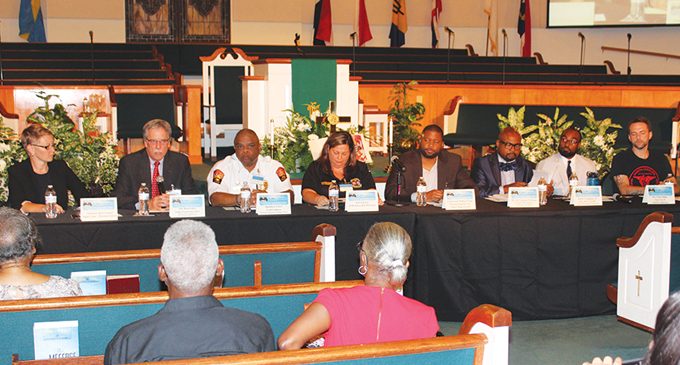Annual conference targets drug addiction
Photo by Timothy Ramsey

The Corner 2 Corner Drug Dealers & Street Life Conference held at Union Baptist Church routinely tackles serious issues and topics that are damaging the community. Drug addiction, specifically the opioid epidemic, was the topic of discussion during the community forum held at the church on Thursday, Aug. 31.
Opioids are a type of medicine often used to relieve pain. They are most often prescribed to relieve pain from toothaches and dental procedures, surgeries and chronic conditions such as cancer. Statistics say that 91 people die daily from opioids. They are also responsible for more annual deaths than car accidents.
The panel discussion featured individuals from all different vantage points of the epidemic. The panelist included lawyer Kerri Sigler; Judge Lawrence Fine; Fire Battalion Chief Fred Gethers; Forsyth County EMS Tara Tucker; Winston-Salem Police Department Lt. William Penn; Rev. Dr. Lamonte Williams, president of the Ministers’ Conference of Winston-Salem and Vicinity; Counselor Mark Covington Jr. of George Washington University; and opioid survivor Colin Miller.
Bishop Sir Walter Mack Jr. was the moderator for the panel. He pitched questions toward each panelist to gauge their different perspectives on the epidemic. He says he wanted to hold the discussion because of how far reaching this epidemic has become.
“So many times when we think about drug users, we think about people who are just on the street,” said Mack. “What we are discovering is that there are attorneys, executives and pastors who are addicted to pain medication, so what better time to address the issue than now. The more we educate and enlighten, the more we can begin to hold each other accountable.”
Sigler and Fine addressed how opioid addiction has impacted the court system from the defense attorney and judge perspectives, respectively, along with the importance of the return of the drug treatment court.
“When the court was here last time, the statistics showed that it costs $27,000 to keep an offender in jail for a year but it only cost $6,000 to keep that same offender in drug treatment court for a year,” says Sigler. “It only cost $1,200 to keep them on regular probation, which has shown to not be intensive enough to solve the addiction problem.”
“Drug treatment court wasn’t the absolute cheapest option, but in terms of the options that work, it was absolutely the best benefit,” she went on to say. “The idea that they cut the program to save money made no sense because you chose the option that was four times more expensive.”
Penn, who also worked undercover during the crack cocaine epidemic, says there is no difference between the crack cocaine and opioid epidemics. He feels those who are addicted to the drug should be treated while those selling and benefiting financially from the drug deserve to be in jail.
“Both are equally destructive; the difference with crack cocaine was the violence, turf wars and the fighting over the money,” he said. “With opioids, it’s a depressant where if you take too much of it your heart will stop, so one drug is more physical while the other is more societal.”
From the faith perspective, Williams says, “ The Church needs to push to that uncomfortable place of conversation. We must also be able to push to bring those to the forefront to acknowledge that there is a diabolical tension in our community. It’s an uncomfortable conversation, but we know from a legal perspective there are so many African-Americans who are doing the same thing their white counterparts are doing but are labeled differently. When blacks were overdosing, there was no epidemic, but now with soccer moms and affluent people overdosing, now it’s an epidemic.”
Miller, addiction survivor, says the toughest part of recovery was the lack of resources. He feels you have to meet people where they are to give them options for recovery if they are seeking such. He said he wanted to help get others off of drugs because there were people that helped him during his recovery.
“They will spend money to throw you in jail but when you want treatment without having insurance, it’s just not there,” Miller said. “The window of opportunity for recovery when you’re addicted to something is not very big.”
Over the time he was using drugs, Miller says, he was resuscitated on six different occasions. He says when you are addicted, the thought of having your heart stop wasn’t what made him want to stop. For him it was the wear and tear that he was putting on his body along with seeing friends die that motivated him to stop.
Covington says he feels the crack cocaine and opioid epidemics are definitely looked upon differently because of the communities they are afflicting.
“I think they are looked upon differently based on race,” he said. “I think it is a racial issue mainly because of the fact we see who it’s affecting. Now that it is affecting people in white collar jobs, we are starting to see people caring. Opioids have always been a problem, but now that it’s hitting a certain demographic, it’s coming to light.”











